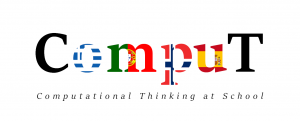Αρχική » Άρθρα με ετικέτα 'computational thinking'
Αρχείο ετικέτας computational thinking
Guide for Computational Thinking
Guide for Computational Thinking Erasmus CT Guide_vF.01 Scenarios in English Erasmus-CT-Guide_vF.01 PART B Scenarios in Greek Erasmus-CT-Guide_vF.01 Scenarios EL Scenarios in Portuguese Erasmus-CT-Guide_vF.01 Scenarios PT Scenarios in Norwegian Erasmus-CT-Guide_vF.01 Scenarios NO Scenarios in Spanish Erasmus-CT-Guide_vF.01 Scenarios ES
Computational Thinking at school / CompuT
Erasmus plus KA201, Exchange of best practices Title: CompuT «Computational Thinking at school» Project code: 2019-1-EL01-KA201-062883 Join our mailing list here Email erasmus@dide.dod.sch.gr Summary The project “Computational Thinking at School” aims to introduce computational thinking and its implications in pedagogies in the educational field. The high impact of Computer Science in science, economy and society […]
Computational Thinking Skills
Computational Thinking Skills Full article here DigitalCareers_CTIAWorksheets_CTdefinitions Source https://digitalcareers.csiro.au
BBC What is computational thinking?
Computers can be used to help us solve problems. However, before a problem can be tackled, the problem itself and the ways in which it could be solved need to be understood. Computational thinking allows us to do this. Computational thinking allows us to take a complex problem, understand what the problem is and develop […]
10 Reasons to Teach Coding – Sylvia Duckworth
Coding allows students to create content, not just consume it. Coding empowers students and give them tools to express themselves in really cool ways. Coding teaches storytelling with games and animations. Coding is a place for students to take risks and fail safely. Coding is inclusive and builds self-confidence Coding supports many principles of mathematics […]
BBC Computational thinking in practice
A complex problem is one that, at first glance, we don’t know how to solve easily. Computational thinking involves taking that complex problem and breaking it down into a series of small, more manageable problems (decomposition). Each of these smaller problems can then be looked at individually, considering how similar problems have been solved previously […]




